Like many with a fondness for historical fashion, the allure of Victorian gowns – with their intricate layers, vibrant colors, delicate ribbons, and undeniable elegance – often captures my imagination. As someone deeply rooted in the American Southwest, an Arizona native and Daughter of Utah Pioneers now residing in Denver, I find myself particularly intrigued by the clothing of pioneer women. This blend of personal interest and regional heritage has led me to explore the fascinating world of pioneer fashion and how it diverged from the established styles of Eastern cities during the 19th century.
Pioneer women’s wardrobes were a carefully considered balance of practicality, propriety, and personal expression. From the need for durable fabrics to the desire to maintain a sense of decorum, their clothing choices reveal much about the realities of frontier life. This exploration will delve into the essential elements of pioneer women’s attire, laying the groundwork for a deeper dive into specific aspects of their fascinating fashion.
Defining the Frontier Context
For the scope of this discussion, “frontier” refers to the regions west of Missouri and Arkansas, spanning roughly from 1850 to 1890. The clothing styles examined are primarily those worn by women homesteaders and members of settled frontier communities. The focus is largely on the experiences of white settlers migrating westward from the East.
It’s captivating to note that frontier clothing was less about social status and conspicuous consumption, and more about the shared experience and aspirations of families venturing into the uncharted territories of the American West. Functionality and adaptability were paramount, reflecting the collective spirit of exploration and resilience.
The Foundation: Undergarments
Interestingly, the undergarments worn by women on the frontier were not drastically different from those fashionable in Eastern cities. The foundational piece was the chemise, a lightweight cotton slip worn next to the skin. Its primary purpose was hygiene, acting as a barrier between the body and outer garments and being laundered frequently. Pantalets, made of flannel or cotton, followed, providing modesty and warmth – a precursor to modern underpants in an era where such garments were not yet common.
Contrary to initial assumptions, corsets were a staple even in pioneer wardrobes. Many women journeying west were driven by the hope of a better future, be it economic opportunity or religious freedom. These were women who valued propriety and maintained a sense of “respectability.” For them, forgoing a corset, a garment considered essential for proper attire at the time, was simply not an option.
While the rigors of daily labor might have led some women to loosen or temporarily remove their corsets during strenuous tasks, the majority of frontier women brought corsets with them and wore them as much as possible.
Following the corset came petticoats, often multiple layers depending on the formality of the occasion or the weather. Stockings were essential for venturing outside or receiving guests, typically held up by garters or tucked into the pantalets – a detail that might strike modern sensibilities as somewhat cumbersome.
Fabrics of the Frontier
Calico emerged as the quintessential fabric for pioneer clothing. Often envisioned as quaint floral prints, calico is actually a type of fabric made from unprocessed cotton. Its simple weave and lighter weight compared to canvas made it ideal for the frontier environment. Calico was lightweight, durable, and relatively easy to clean – crucial qualities for the demands of pioneer life. General stores offered calico in various dyed options, and women also employed store-bought or natural dyes derived from leaves, bark, berries, and fruits to create a wider palette.
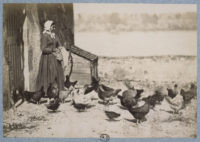 Pioneer woman in daily wear, showcasing a practical yet modest pioneer dress for women.
Pioneer woman in daily wear, showcasing a practical yet modest pioneer dress for women.
Cotton and silk fabrics were still reserved for “Sunday best” and more formal dresses, and many women brought such garments with them as they moved westward.
While fabrics were obtainable at general stores, accessibility varied significantly depending on location and proximity to settlements. In more isolated areas, families often had to produce their own fabrics – a complex process worthy of its own exploration.
Daily Dresses: Practicality Meets Modesty
Regardless of their backgrounds in the East, women in frontier settlements were integral to establishing and maintaining homes and farms. Their days were filled with cooking, cleaning, childcare, laundry, and often fieldwork. The success of family farms and enterprises depended on the physical contributions of every member, and domestic tasks were not outsourced. Frontier women quickly adapted to a life of demanding manual labor.
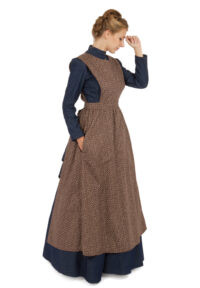 Pioneer calico apron, a common accessory for pioneer dresses for women during daily chores.
Pioneer calico apron, a common accessory for pioneer dresses for women during daily chores.
The general dress styles of the era – fitted bodices and full skirts – were adapted for frontier living. Skirts for everyday dresses were hemmed approximately three inches shorter to facilitate movement and daily tasks. Weights might be sewn into the hems to prevent skirts from blowing up in windy conditions, ensuring modesty.
Bodices remained fitted, but sleeves were loosened and extended to the wrists, often paired with high collars to shield the skin from the sun’s harsh rays.
Laundering pioneer clothing was a significant undertaking. “Wash dresses,” made of easily washable white cotton with printed patterns, gained popularity around 1867. These two-piece dresses were available in stores and quickly replicated by seamstresses throughout the West, catering to women across socioeconomic lines who valued practicality in their daily wear. This adaptation in fashion highlights how necessity shaped clothing choices on the frontier.
Sunday Best: Maintaining Tradition
 A frontier couple in their Sunday best, the woman wearing a more elaborate pioneer dress for church.
A frontier couple in their Sunday best, the woman wearing a more elaborate pioneer dress for church.
While frontier life could be isolating, settlements often developed communities centered around churches. Church attendance was generally an expected aspect of community life. Although accounts exist of women in impoverished communities attending church barefoot, it was more typical for women to possess dresses specifically designated for Sundays. However, historical records often focus on more privileged settlers, making it challenging to definitively ascertain the most common experience across all frontier communities.
“Sunday best” dresses on the frontier mirrored fashionable styles in Eastern cities. Full skirts, worn over petticoats and corsets, were standard. Sleeve styles reflected current trends, including puffed bell, leg-o’-mutton, or pagoda sleeves. Skirt styles also kept pace with fashion, featuring crinoline, hoop, or bustle silhouettes depending on the prevailing decade.
Lighter colors were favored by younger women and the newly married, transitioning to darker hues as they aged. These dresses were completed with the most fashionable hats available, kid gloves, and low-heeled boots.
Dressing for Social Gatherings
Beyond daily wear and Sunday attire, women on the frontier often reserved dresses for social occasions. Dances, holiday celebrations, picnics, and other community gatherings were common, and women, accustomed to dressing for social events in the East, continued this practice on the frontier whenever possible.
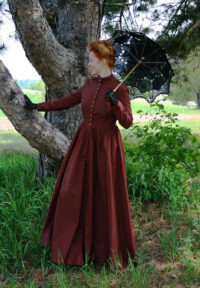 Mary Chestnut's Americana Victorian Cotton Dress, an example of a fancier pioneer dress for social occasions.
Mary Chestnut's Americana Victorian Cotton Dress, an example of a fancier pioneer dress for social occasions.
These “social dresses” were highly valued. Women might order fabrics from general stores and eagerly await the opportunity to create fashionable garments. Godey’s Ladies Book, a widely circulated magazine, served as a crucial fashion resource, with patterns and styles eagerly copied by frontier women.
Fabric availability for new dresses depended heavily on the distance to towns and general stores. In more remote areas, women might have limited dress options, using their finest dress for special events and enhancing it with embellishments to create a more festive ensemble. Hand-crocheted collars, shawls, and other accessories were popular ways to elevate an outfit.
The Importance of Accessories
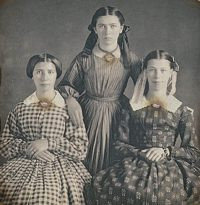 Frontier girls accessorizing their pioneer dresses, highlighting the importance of finishing touches.
Frontier girls accessorizing their pioneer dresses, highlighting the importance of finishing touches.
Accessories played a significant role in frontier women’s wardrobes. Beyond the fundamental hoop skirts and calico dresses, the finishing touches were highly important. Jewelry and accessories were emphasized in historical accounts, indicating their importance in completing a pioneer woman’s look.
Frontier women accessorized with:
- Aprons
- Boots
- Brooches
- Lockets
- Earrings
- Precious stones and metals
- Hair adornments
- Hats
- Collars and cuffs
- Gloves
- Undersleeves
- Parasols
- Fans
- Handbags
- Shawls
A Lasting Pioneer Legacy
Exploring the clothing of pioneer women offers a fascinating glimpse into the past. As someone delving into my own pioneer ancestry, the subject has become deeply personal. While “prairie style,” “pioneer,” and “western wear” clothing are readily available today, understanding the historical context of how women balanced propriety, beauty, and fashion amidst the physical demands of frontier life is crucial.
This exploration is just the beginning. Future discussions will delve deeper into specific aspects of pioneer fashion, such as accessories and their significance.
Embody the Pioneer Look Today:
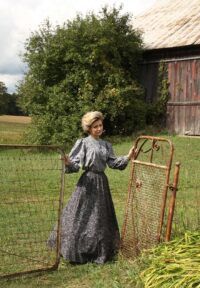 A woman wearing a pioneer calico blouse and skirt, a typical example of pioneer dresses for women.
A woman wearing a pioneer calico blouse and skirt, a typical example of pioneer dresses for women.
Browse our entire pioneer clothing collection
Pioneer Calico Blouse and Skirt
Harper Victorian Pioneer Dress
Pioneer Blouse, Apron and Skirt

